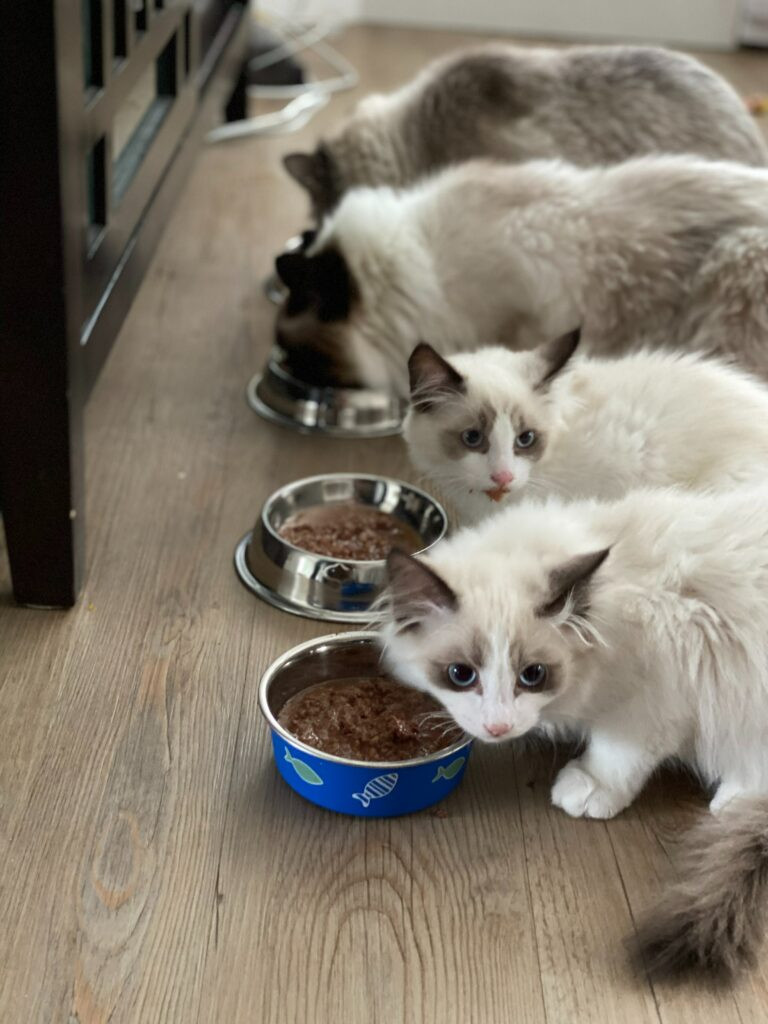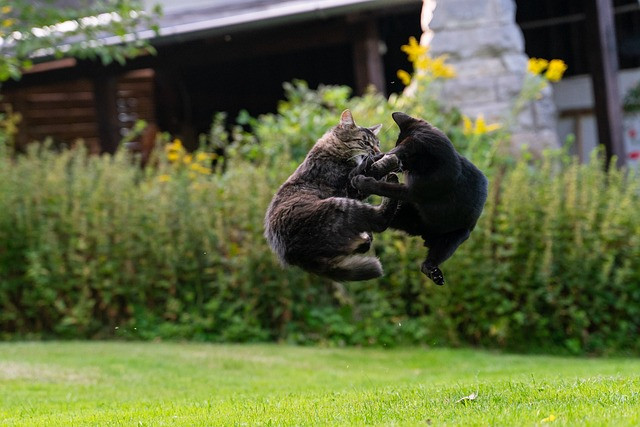Living with multiple cats can fill your home with purrs, cuddles, and the delightful sight of feline companions entertaining each other. However, the harmony can be disrupted by Cat Fights, turning a peaceful multi-cat household into a stressful environment. Even cats who were once the best of friends can suddenly become adversaries under certain circumstances.
You might witness the event that triggers the first cat fight, or it could happen without a clear cause. Sometimes, the reasons behind feline aggression are not immediately obvious to us.
A common scenario that leads to cat fights involves a seemingly routine vet visit. Imagine two cats who have coexisted peacefully for years. One cat goes to the veterinarian for a check-up, a dental procedure, or any other medical reason. Upon returning home, this cat may act slightly differently, which is understandable given the stress of a vet visit. (Remember, regular veterinary check-ups are crucial for your cat’s well-being.)
Initially, the cats might seem fine. But then, either immediately or after a short period, a cat fight erupts, forcing you to intervene and stop the cat fight. This single incident can fracture their relationship. Cats who once lounged and played together now can’t be in the same room without conflict. Even when they are in the same space, the tension is palpable, and they seem more stressed than before.
 Four white cats peacefully eating from separate bowls, highlighting harmonious feline coexistence and the absence of cat fights.
Four white cats peacefully eating from separate bowls, highlighting harmonious feline coexistence and the absence of cat fights.
Life is undoubtedly better when cats get along. Photo by Fernando Jorge.
Witnessing your once-friendly cats become enemies is distressing for cat owners. The desire to restore peace and see your beloved pets as buddies again is strong. You long for the days when you didn’t have to worry about sudden hisses, swats, and full-blown cat fights. You might wonder if your cats’ relationship will ever return to normal.
Unpacking the Reasons Behind Cat Fights
While the reasons for cat fights are varied, the scenario described above often stems from what’s known as non-recognition aggression. It might seem strange to us, but a cat’s sense of smell plays a vital role in how they recognize each other. When a cat returns from the vet smelling and behaving differently due to stress, medication, or unfamiliar scents, their housemate may perceive them as a stranger.
Cats are inherently territorial, and unfamiliar cats are often viewed with suspicion and hostility. One cat, feeling threatened by this “new” cat in their territory, may act defensively. The returning cat, perhaps initially confused by the aggression, may then feel threatened themselves, leading to a cycle of fear and aggression every time they encounter their former companion.
In other situations, cat fights might occur because the cats never truly got along from the start. This could be due to personality clashes or improper introduction methods. Fear becomes the dominant emotion, and each cat fight reinforces this fear-based response, escalating the problem.
 Dramatic photo of two cats mid-air during a cat fight, illustrating aggressive feline behavior and the disruption of a peaceful multi-cat household.
Dramatic photo of two cats mid-air during a cat fight, illustrating aggressive feline behavior and the disruption of a peaceful multi-cat household.
This is definitely not playful wrestling; it’s a serious cat fight. Photo by René Schindler.
Another trigger for cat fights can be misdirected aggression. If a sudden, scary event occurs, like a loud noise such as dropping a pan, a cat might become startled and lash out at the nearest perceived threat. If another cat is nearby, they may misinterpret their housemate as the source of their fear or try to relieve their anxiety by attacking the other cat. This is known as redirected aggression and can quickly lead to a cat fight.
Responding to Cat Fights: Immediate and Long-Term Solutions
When cat fights break out, your immediate instinct is likely to restore peace as quickly as possible. Sometimes, the cats may resolve the conflict themselves without much intervention. However, in many cases, resolving cat fights requires patience and a structured approach. To help your cats regain their friendly relationship, you might need to undertake a process called reintroduction.
The Reintroduction Process: Rebuilding Feline Relationships
Reintroductions are designed to help cats relearn that their housemate is not a threat and, ideally, to create positive associations when they are in each other’s presence. When executed correctly, reintroduction has a high success rate, but it can be a lengthy process, often taking months to achieve a semblance of normalcy. The more negative interactions the cats have, the more challenging the reintroduction process becomes. In some unfortunately severe cases, despite best efforts, rehoming one of the cats might be the most compassionate solution.
Reintroduction essentially involves repeating the steps of introducing cats for the very first time, but with greater precision and at a slower pace. Crucially, during the reintroduction process, the cats must be kept completely separate, except during controlled interaction sessions.
Because reintroduction is time-consuming and emotionally demanding for cat owners, navigating it alone can be challenging, even with a reliable guide. Fortunately, feline behavior experts are experienced in guiding cat owners through this process. In fact, reintroductions are a very common reason why cat owners seek professional help for their cats’ behavior issues through behavior consultations. If you’re committed to working through a reintroduction and are prepared for the effort involved, professional guidance can be invaluable.
Alternatives to Reintroduction: Exploring Other Options
If a full reintroduction feels daunting or you want to explore less intensive options first, there are a few strategies you can try to mitigate cat fights. While their success rates vary, they may be worth attempting. And, if you’re unsure whether reintroduction is necessary for your fighting cats, seeking advice through a behavior consultation can provide clarity.
You might have heard recommendations for pheromone diffusers. While they are unlikely to cause harm, and some cat owners find them mildly helpful for general stress reduction, they are generally not a primary solution for resolving serious cat fights. You can try them, but manage your expectations.
Addressing the Root Cause of Cat Fights
Identifying and resolving the underlying cause of your cats’ conflict is often the most effective approach, especially if the cat fights are triggered by resource guarding or environmental stressors. Try to address the core issue without resorting to punishment or methods that scare your cats, as fear-based approaches will likely worsen aggression. For instance, if your cats are fighting over a favorite cat tower, consider adding a second cat tree or other vertical space. Providing ample resources like food bowls, water stations, litter boxes, scratching posts, and resting areas can reduce competition and conflict. While addressing resource issues can prevent future fights, you might still need to work on repairing any damage to their relationship caused by previous cat fights.
Another less intensive alternative is temporary separation. Try separating the cats completely for a few hours or even a few days to allow tension to dissipate. During separation, ensure each cat has all their essential needs met in their separate spaces. Crucially, they should not be able to see each other during this separation period. You might need to use an under-the-door draft guard to prevent interaction under doors or window film to block visual access through windows. This separation can give cats a break from the conflict and allow stress hormones to decrease, sometimes leading to a reset in their interactions.
What to Avoid When Dealing with Cat Fights
There are some common, yet outdated, approaches to cat fights that you should absolutely avoid. In the past, it was sometimes advised to “let cats fight it out,” but we now know this is detrimental and harmful advice. Cats are unlikely to “work it out” on their own, and allowing cat fights to continue puts them at risk of serious injury. It’s always better to proactively intervene and guide them towards a peaceful coexistence.
While some online resources suggest feeding cats near each other to create positive associations, this approach is not as universally helpful as it’s often portrayed and is not recommended in the most recent AAFP guidelines on intercat tension. While positive associations are beneficial, cats generally prefer to eat separately. Forcing them to eat together can actually increase stress and tension, potentially leading to more conflict. Cats may tolerate eating near each other simply because they are hungry, but underlying animosity can still persist. It’s best to skip this method.
If your cats are actively engaged in a cat fight, your immediate priority is to safely break up the cat fight without putting yourself in harm’s way. Never insert your hands directly between fighting cats, as this is a surefire way to get bitten by a cat. Use loud noises, a spray of water, or throw a blanket over them to interrupt the fight and create a safe distance.
Is There Hope for My Fighting Cats?
This is the most frequently asked question from cat owners facing inter-cat aggression. The good news is that in many cases, yes, there is hope for improvement! While various factors can influence the likelihood of cats tolerating each other, with patience and the right strategies, you can often achieve a more peaceful multi-cat household. Sometimes, with minor adjustments, the situation will naturally improve. Other times, you’ll need to actively guide your cats through a reintroduction or implement other management techniques. With consistent effort and understanding, you can often transform a home filled with the constant hissing of cats into a more harmonious environment, free from the stress of ongoing cat fights.
Need Expert Help with Your Fighting Cats?
Schedule a Cat Behavior Consultation to get personalized guidance and develop a tailored plan to address your cats’ aggression and restore peace to your home.


